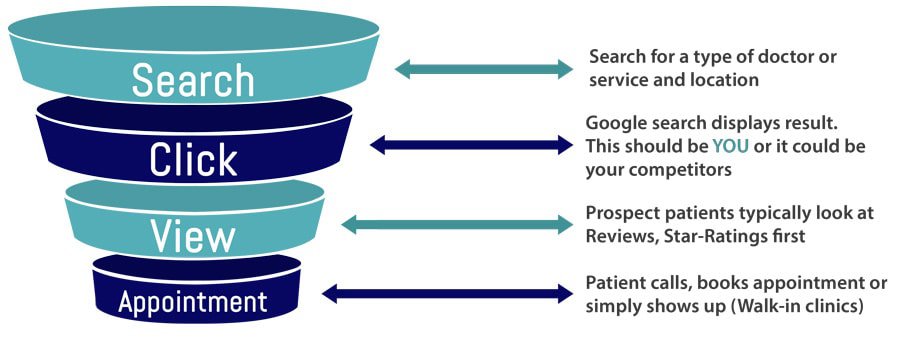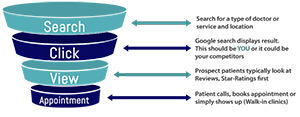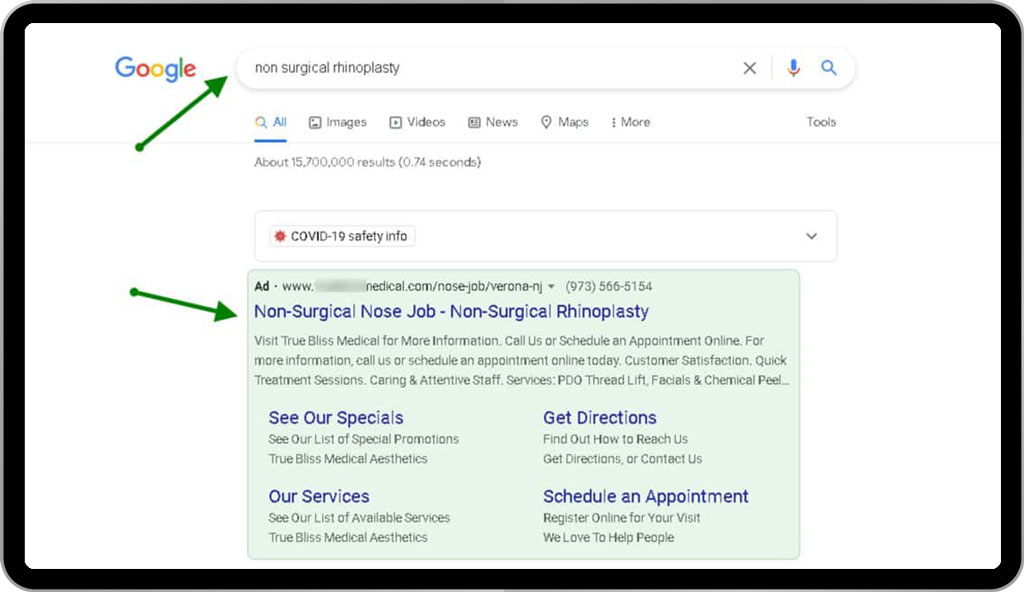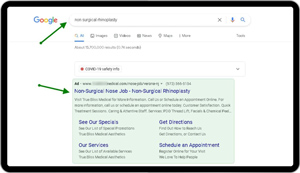Google PPC Expert for Med Spas: PatientGain’s Pricing is simple and transparent, plus 10+ years of experience in setting up and managing Medical Spa PPC Campaigns $299+18% of the total spend
Can Google PPC Ads be profitable to MedSpas?
Yes, Google Ads can be highly profitable for Med Spas by capturing high-intent users actively searching for treatments like Botox and fillers, providing instant visibility to drive leads and appointments. Success depends on precise keyword targeting, well-optimized landing pages, conversion tracking, and ongoing campaign management to ensure effective ad spend and a strong return on investment.


How PPC ads work for a med spa?
Google PPC (Pay-Per-Click) ads work for a med spa by placing a targeted advertisement for your services directly in front of potential clients at the exact moment they’re searching for them, allowing you to pay only when they click your ad. Google Pay-Per-Click (PPC) ads, also known as Google Ads, are a powerful tool for medical spas to drive traffic and attract new clients. Google Ads allow businesses to place ads on Google’s search results page, Google’s Display Network, and YouTube. When someone clicks your ad, you pay a fee, hence the term “Pay-Per-Click.”
Example of a non-surgical nose job ad in the NJ area


1. Setting Up PPC adwords campaign
Google Search Ads are text ads that appear at the top or bottom of the search engine results page (SERP) when a user searches for keywords related to your business. These ads are highly effective because they target people actively searching for specific services.
How it Works for Med Spas:
PatientGain creates and manages your medical spa ads targeting high-intent keywords such as:
- “Botox near me”
- “Laser hair removal in [City Name]”
- “Chemical peels for acne scars”
When someone searches for these terms, your ad appears, and if they click on it, you’re charged for that click.
Example:
- Search query: “Botox injections in Miami”
- Ad: “Smooth Wrinkles with Botox at [Med Spa Name] – Book Now for a Free Consultation!”
2. Setting Up Keywords
The heart of Google Ads lies in choosing the right keywords that potential clients are using to search for services you offer. These keywords can be grouped into different categories, such as:
- Service-related keywords: “facelift injections,” “laser hair removal,” or “microneedling.”
- Location-based keywords: “Botox in Miami,” “best med spa in Los Angeles.”
- Brand-related keywords: “HydraFacial at [Med Spa Name].”
How to Choose Keywords:
- Use Google Keyword Planner (a free tool within Google Ads) to research the keywords people are searching for in your area. This will help you identify terms with high search volume and moderate competition.
- Target local and service-specific keywords. For example, if your med spa specializes in non-invasive body contouring, target keywords like “CoolSculpting near me” or “body contouring [City Name].”
Example:
If your spa specializes in Botox, some keywords could be:
- “Botox injections for wrinkles”
- “Botox near [City Name]”
- “Anti-aging Botox treatments”
3. Ad Creation
Once you’ve selected your keywords, you’ll create ads that appear when people search those keywords. Google Ads allows you to create text ads with:
- A headline that captures attention
- A description highlighting your services and unique selling points (USPs)
- A call-to-action (CTA) that encourages the user to take action (e.g., “Book your free consultation today”)
Ad Structure Example for a Med Spa:
- Headline 1: “Get Smooth Skin with Botox at [Spa Name]”
- Headline 2: “Expert Injectors & Natural Results”
- Description: “Book a Botox session today and save 20% on your first treatment. Safe, effective, and non-invasive.”
- CTA: “Call Now to Book Your Appointment!”
4. Bidding and Budgeting
Google Ads operates on a bidding system. You set a maximum bid—the highest amount you’re willing to pay for a click on your ad. You also set a daily or monthly budget to control how much you spend.
How Bidding Works:
- Cost-Per-Click (CPC): You bid for a specific keyword, and the amount you pay for each click depends on the competition for that keyword. More competitive keywords (like “Botox near me”) tend to have a higher CPC.
- Ad Auction: Google runs an auction every time someone performs a search. Your ad placement depends on your bid amount and the quality score of your ad (i.e., how relevant your ad is to the search term, how good your landing page is, etc.).
Example:
If you bid $3 for the keyword “Botox Miami” and your ad has a high relevance to the keyword, you may pay $2 per click, even though your bid was $3.
5. Tracking Conversions
Tracking conversions (the actions you want users to take, such as booking an appointment or calling your med spa) is crucial to evaluate the success of your ads.
How to Track Conversions for a Med Spa:
- Call Tracking: If a potential client calls your spa after clicking your ad, Google Ads can track this as a conversion. You can use call tracking numbers that are only displayed to users who clicked your ad.
- Form Submissions: If you have an online booking form or a contact form, Google Ads can track when someone fills it out and submits their information.
- Bookings: If your med spa has an online booking system, you can set up conversion tracking to record when someone books an appointment.
6. Using Extensions to Enhance Ads
Google Ads allows you to use ad extensions to add additional information to your ads, making them more compelling and informative. These extensions include:
- Location extensions: Show your business address to encourage local clients.
- Call extensions: Allow users to call your spa directly from the ad.
- Site link extensions: Add extra links to other pages on your website, like “Special Offers,” “Services,” or “Client Testimonials.”
Example:
You can set up a location extension that shows your address with a map in your ad, making it easier for local clients to find your spa.
7. Analyzing and Optimizing Performance
Once your ads are live, it’s important to analyze performance and optimize the campaign for better results.
Key Metrics to Track:
- Click-Through Rate (CTR): The percentage of people who click your ad after seeing it. A high CTR indicates that your ads are relevant and compelling.
- Cost Per Acquisition (CPA): How much you spend to acquire one customer. The goal is to keep your CPA lower than the lifetime value (LTV) of a client.
- Conversion Rate: The percentage of clicks that result in desired actions (e.g., form submissions or bookings).
You can adjust your bids, keywords, and ad copy based on these metrics to improve performance and reduce costs.
Example:
If a keyword like “laser hair removal in [City]” isn’t converting, you may decide to adjust your ad copy or remove it from your campaign to focus on more effective terms like “affordable laser hair removal near me.”
8. Remarketing Ads
Remarketing is another powerful feature of Google Ads. Remarketing allows you to target people who have already visited your website but didn’t convert (i.e., didn’t book an appointment). However, Google does
not allow remarketing to medical patients due to its strict personalized advertising policies regarding sensitive health information. The intent is to protect user privacy and prevent ads related to personal health issues from feeling intrusive or exploitative.
Summary
Google PPC ads are an effective and measurable way for med spas to attract local, high-intent clients. By targeting the right keywords, creating compelling ads, and tracking conversions, med spas can generate leads and turn clicks into appointments. The ability to set specific budgets, adjust bids, makes Google PPC Ads a valuable tool to grow a med spa’s client base efficiently.
